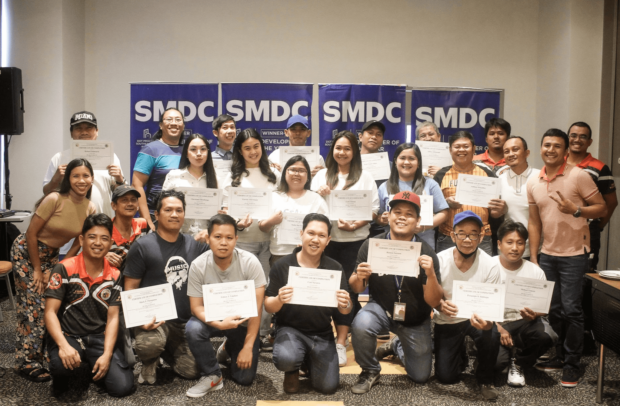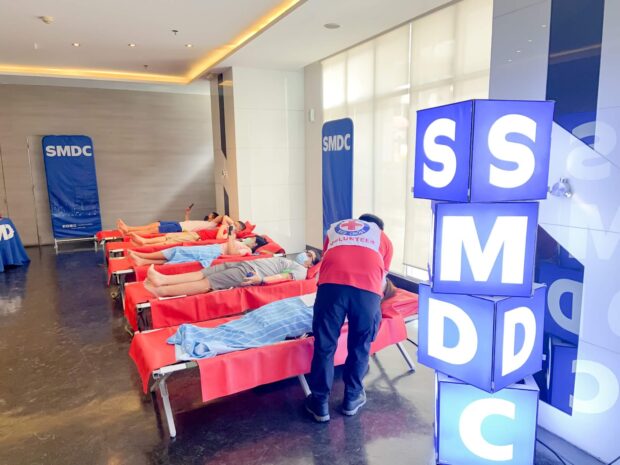SMDC rolls out programs to promote Disaster Risk Reduction
SMDC rolls out programs to promote Disaster Risk Reduction Inquirer.net


With a thorough understanding of the Philippines’ urban landscape and the risks it is exposed to as one of the most disaster prone countries in the world, SM Development Corporation (SMDC) has long been a forerunner in the development of sustainable, resilient communities.
Ready to Rescue
Recognizing the value of a strong social fabric in building resilience, SMDC recently launched “Ready To Rescue,” a disaster-preparedness training program that aims to educate more Filipinos on the impacts of climate change, and the knowledge and skills needed to effectively respond and recover from disasters.
In partnership with Philippine Red Cross, City Disaster Risk Reduction and Management Offices (CDRRMO), and its Quick Response division, SMDC gathered members of the local government and community volunteers for a two-day training session in Iloilo and Bacolod.

Rene Tamayo, Barangay Tanod Team Leader of Brgy. Granada in Bacolod City, was one of the many attendees of Ready to Rescue’s Bacolod leg. When it comes to averting the loss of life and damage to property, he said: “I now realize that unpreparedness is not an option.”
Meanwhile, Alfredo Talimodao Jr., Chairman of Brgy. Granada, said as a community leader, he found early warning systems, as well the timely and effective dissemination of information, to be imperative. “[I plan] to collaborate with local authorities and fellow community members to establish a comprehensive disaster response plan, focusing on improving communication channels and educating others about the importance of preparedness,” said Talimodao Jr.
The training introduced concepts such as the DRRM system and the Incident Command System, which enable a systematic response to disasters. Demonstrations and practical knowledge were provided on fire, earthquake, flood, and tropical cyclone survival and evacuation, simple first aid for injuries, and basic life support. A Disaster Control Group was also developed during the sessions.
Good Guys Help Save Lives
Did you know that one bag of blood can save up to three lives? In times of medical emergencies, emergency surgeries, and critical treatments, a reliable and adequate blood supply can make a life-saving difference.

Steadfast in its partnership with Philippine Red Cross, SMDC is a leading advocate of blood donation. Through their “Good Guys Help Save Lives” initiative, SMDC empowers residents, tenants, employees, and members of neighboring communities to help address the persistent challenge of blood shortages in healthcare facilities through blood donation.
Regularly conducted in different SMDC properties and SM offices across the country, the “Good Guys Help Save Lives” initiative not only raises awareness on the importance and benefits of blood donation, but also fosters a culture of care and compassion.
A shared social responsibility
At the core of disaster risk reduction and management is the idea of shared social responsibility. Climate change is a global concern that knows no borders. It affects ecosystems, economies, and livelihoods on a global scale. As such, it demands a collective, “whole-of-society” response from individuals, businesses, and governments.
A recipient of Carousell Property Awards’ “Best Developer for Building Sustainable Communities” and Dot Property Philippines Awards’ “Special Recognition for Corporate Social Responsibility,” SMDC seeks to be a partner in nation-building in all aspects — advocating for humanitarian agenda, pushing sustainable development forward, and strengthening public-private partnerships to help make the Philippines more resilient.
For one, SMDC and its parent company, SM Prime Holdings Inc., are members of the Private Sector Alliance for Disaster Resilient Societies (ARISE) — a global network of private sector entities led by the United Nations Office for Disaster Risk Reduction (UNDRR) that collaborate to implement the targets of the Sendai Framework. It also co-chairs the National Resilience Council in the Philippines.

From master-planning its projects based on global standards, to creating avenues for individuals to actively participate in safeguarding communities — SMDC leverages on its expertise in real estate development to make a meaningful impact in the attainment of a resilient and sustainable future.
To know more about the SMDC, follow them on Facebook, Instagram, YouTube, Twitter, and Tiktok, or visit the SMDC website.
ADVT.
SDGs, Targets, and Indicators
1. Which SDGs are addressed or connected to the issues highlighted in the article?
- SDG 11: Sustainable Cities and Communities
- SDG 13: Climate Action
- SDG 17: Partnerships for the Goals
The article discusses SM Development Corporation’s efforts to develop sustainable and resilient communities in the Philippines, which aligns with SDG 11. It also mentions the impacts of climate change and the importance of disaster preparedness, which are connected to SDG 13. Additionally, SMDC’s partnerships with organizations like the Philippine Red Cross and its involvement in global networks like ARISE demonstrate its commitment to partnerships for achieving the SDGs, specifically SDG 17.
2. What specific targets under those SDGs can be identified based on the article’s content?
- SDG 11.5: By 2030, significantly reduce the number of deaths and the number of people affected and substantially decrease the direct economic losses relative to global gross domestic product caused by disasters, including water-related disasters, with a focus on protecting the poor and people in vulnerable situations.
- SDG 13.1: Strengthen resilience and adaptive capacity to climate-related hazards and natural disasters in all countries.
- SDG 17.17: Encourage and promote effective public, public-private, and civil society partnerships, building on the experience and resourcing strategies of partnerships.
The article highlights SMDC’s disaster-preparedness training program, which aims to educate Filipinos on climate change impacts and equip them with the knowledge and skills needed to respond and recover from disasters. This aligns with SDG 11.5, as it contributes to reducing the number of deaths and economic losses caused by disasters. SMDC’s partnerships with the Philippine Red Cross and local government offices also demonstrate its commitment to SDG 17.17.
3. Are there any indicators mentioned or implied in the article that can be used to measure progress towards the identified targets?
Yes, the article mentions several indicators that can be used to measure progress towards the identified targets:
- Number of people trained in disaster preparedness
- Number of community volunteers involved in disaster response
- Number of early warning systems implemented
- Timeliness and effectiveness of information dissemination during disasters
- Establishment of comprehensive disaster response plans
- Improvement of communication channels for disaster response
- Number of blood donations collected through the “Good Guys Help Save Lives” initiative
These indicators reflect the efforts and outcomes of SMDC’s disaster-preparedness training program, blood donation initiatives, and partnerships with relevant organizations.
SDGs, Targets, and Indicators
| SDGs | Targets | Indicators |
|---|---|---|
| SDG 11: Sustainable Cities and Communities | 11.5: By 2030, significantly reduce the number of deaths and the number of people affected and substantially decrease the direct economic losses relative to global gross domestic product caused by disasters, including water-related disasters, with a focus on protecting the poor and people in vulnerable situations. |
|
| SDG 13: Climate Action | 13.1: Strengthen resilience and adaptive capacity to climate-related hazards and natural disasters in all countries. |
|
| SDG 17: Partnerships for the Goals | 17.17: Encourage and promote effective public, public-private, and civil society partnerships, building on the experience and resourcing strategies of partnerships. |
|
Behold! This splendid article springs forth from the wellspring of knowledge, shaped by a wondrous proprietary AI technology that delved into a vast ocean of data, illuminating the path towards the Sustainable Development Goals. Remember that all rights are reserved by SDG Investors LLC, empowering us to champion progress together.
Source: business.inquirer.net

Join us, as fellow seekers of change, on a transformative journey at https://sdgtalks.ai/welcome, where you can become a member and actively contribute to shaping a brighter future.







